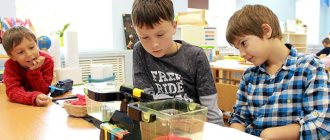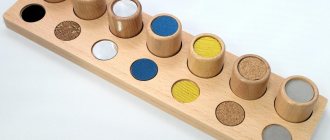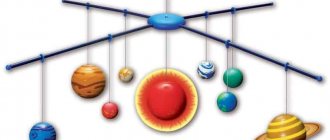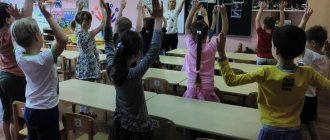The Montessori method is a direction of pedagogy developed in Italy in the 19th century, which is based on the independent activity of children from a very early age. This system has its pros and cons. Children are allowed to independently decide what they will do, acquire knowledge, and do household chores.
Classes are held in groups of different ages with a small number of people. The main condition for the existence of the system is a special environment in which every child has the opportunity to self-realize, and the philosophy presupposes the teacher’s non-interference in the activities of children.
Maria Montessori is a 19th century Italian physician who made significant contributions to pedagogy around the world. After completing her studies, she worked in a clinic for children with mental disabilities, and after some time opened a center for the development of children with normal mental development, but with severe pedagogical neglect. The center worked according to the principles developed and substantiated by Maria Montessori, and her method of developing children was born here. Soon her “Children’s Home” became known almost throughout the world.
ESSENCE AND PRINCIPLES OF THE MONTESSORI METHOD
A brief description of the Montessori method is that adults do not impose their existing experience on the child, but give the opportunity to gain it on their own. Here a special training program is developed, in which development is based on the child’s ability to learn new things at the moment.
The credo of Montessori pedagogy is “help the child do it on his own.”
The main goal is to direct the child’s development in the right direction, with the acceptance of his personality and characteristics, without attempts to break him with his own beliefs.
Achieving the goal is possible thanks to the presence of mandatory rules for teachers:
- It is prohibited to compare children, include competitive aspects in their activities, evaluate them according to some general criteria, encourage, punish or force them to do anything.
- Children are allowed to independently choose the pace and rhythm of their learning, the duration of classes, the direction of development and educational materials.
- The teacher must develop independence in the child in all available ways, respect his choice and create a comfortable environment.
- An educator or teacher should not try to make children like themselves or change the process of development of independence in a child. Ideally, he should remain a neutral observer who creates a comfortable atmosphere for the child's development, regardless of anyone else's opinion.
Summary
The technique has its significant advantages. This is an accessible environment for development and complete freedom of choice. The child learns at a pace that is comfortable for him, which he chooses himself, does not compete with other children and does not experience stress. The adult plays a secondary role, without imposing his vision of the situation on the children.
Disadvantages of the system are isolation from traditional educational methods, possible difficulties with collective learning. The disadvantages can easily be eliminated with a modern, competent approach to the system.
Return to list of publications
BASIC PRINCIPLES OF TRAINING
The basic principle of Montessori pedagogy is, up to one year and older, not to force a child to do anything that he does not want himself. It becomes possible to carry it out thanks to the conditions that naturally develop in the Montessori system:
- every child strives for equal participation in life with adults;
- over time, children understand that this requires learning and gaining their own experience;
- also, kids soon realize that the more and faster they learn, the faster they can get into the adult world;
- The teacher takes a neutral position, does not show his attitude to this or that activity, but only provides assistance at the request of the child.
You can also name a few more basic principles of the Montessori education method:
- The child is the center of the pedagogical process. All work is structured depending on his desires, aspirations, capabilities and characteristics.
- Environment is a fundamental condition for child development. It should be so rich and useful that every child can choose his own place in it and find something interesting to do.
- An adult is a person who helps only upon the request of a child. If this is absent, then it does not interfere in any way with its natural development process.
- Children are allowed to move freely around the classroom.
- Children independently choose materials for classes and study them.
conclusions
Despite their apparent simplicity, M. Montessori’s pedagogical ideas are not easy to implement. Providing a child with “useful” freedom can only be done in a properly prepared space, and despite the child’s independent work with materials, an adult requires a lot of knowledge and skills to truly support the child. Nevertheless, the direction has millions of supporters around the world, as the results of the approach are amazing: children become more confident, pay attention better and demonstrate academic success.
WHAT ARE SENSITIVE PERIODS
Sensitive periods are periods of the child’s greatest sensitivity to learning certain skills and abilities. This is the perfect time for your child to absorb new things. If the sensitive period has not yet begun or has already ended, then the child’s learning will be significantly more difficult. Maria Montessori outlined the following time frames:
- The period of perception of order is from 0 to 3 years. If a child under 3 years old is not used to cleaning up after himself, then at 4-5 years old it will be difficult to accustom him to this. In the Montessori system, children are allowed, for example, to wash the dishes, sweep up spilled garbage, and wash the floor.
- The period of development of actions and movement is from 1 to 4 years. The period during which a child develops muscles and coordination of movements. You need to spend as much time as possible on playgrounds, slides, swings and ladders.
- The period of sensory development is from 0 to 5.5 years. Children experience the world with all their senses: they look, listen, smell, taste, touch. Here ideas about shape, color, weight and geometric shapes are formed.
- The period of perception of small objects is from 1.5 to 5.5 years. This is the time for the formation and development of fine motor skills. During this period, the child learns to string beads, sort through cereals, and assemble puzzles.
- The period of speech development is from 0 to 6 years. The best time to read books, look at different cards, write short stories.
- The period of development of social skills is from 2.6 to 6 years. The baby carefully observes the behavior of adults. Learns to behave in society: to be polite, to communicate, and, if necessary, to restrain one’s emotions.
Rules for working with didactic material
- To encourage the child to take action, the material should be placed at eye level (no higher than 1 meter from the floor)
- The material must be handled with care. The material can be used by a child after an adult explains its purpose to the child.
- When working with material, you should adhere to the following sequence: selecting the material, preparing the workplace, performing actions, monitoring, correcting errors, returning the manual to the place upon completion of work with it.
- It is prohibited to transfer the manual from hand to hand during group classes.
- The material must be laid out in a certain order by the child on a table or rug.
- The child can interact with the material not only following the example of the teacher, but also taking into account his own knowledge.
- The work should gradually become more difficult.
- Having finished the exercises, the child must return the manual to its place, and only after that he can take other materials.
- One child works with one material. This allows you to concentrate. If the material that the child has chosen is currently occupied, you should wait while watching a peer’s work, or choose any other.
Maria Montessori notes that these rules do not apply to group games aimed at developing communication and cooperation skills.
MONTESSORI ENVIRONMENT
Creating the right, structured environment is a prerequisite for the existence of the Montessori teaching method. Without it, it is impossible to build a pedagogical process using this methodology. It presupposes the presence of certain zones in which there is everything for gaining experience and knowledge in a particular field.
PRACTICAL LIFE AREA
The practical life zone allows the child to feel like an adult in everyday life. Here he can learn to wash dishes, sweep the floor, do laundry, and care for dolls, plants and animals. To organize this area, you need indoor plants, busy boards, tablecloths, dishes, various household utensils and safe office supplies.
SENSORY DEVELOPMENT ZONE
The main task of this zone is the development of fine motor skills and sensory perception. Here thinking and memory develop, the first acquaintances with shape, color, temperature, weight and size occur. This zone includes a wide variety of objects that have different properties for perception by the senses: balls, balls, bags, scented and flavored jars, objects of different shapes and sizes.
MATH ZONE
The area that develops mathematical concepts gives the child the first knowledge about numbers and operations with them. Mathematics here is studied through concrete physical forms that can be seen and touched - children gain knowledge in this way much easier than on the basis of theoretical explanations. This area contains various geometric figures and shapes, numbers made from various materials and counting objects.
SPEECH ZONE
This is an area for replenishing vocabulary and teaching a child to read and write. The first acquaintance with letters occurs in tactile form. Large letters made of different materials that attract children's attention are easy to move and form into words.
SPACE ZONE
This zone contains various objects that help children understand the surrounding nature and gain basic knowledge about the natural sciences. Here you will find models of planets, figurines of plants and animals, and sets for conducting various experiments.
The location of zones in space and objects in the zones themselves is the most important condition for the functioning of Maria Montessori’s pedagogical methodology. The more relevant an activity is for a child, the more prominent a place it should occupy in the environmental system.
HOW TO MAKE A DEVELOPMENTAL ENVIRONMENT FOR A CHILD?
For wise parents, the Montessori method of teaching children works even without special devices: the child is given a broom, rag, sponge for washing dishes or a vacuum cleaner when he asked for it and decided to do it himself. It is worth allowing the child to fully participate in the everyday life of the family.
If you want to create a classic developmental environment for a child, then the main thing to do is to divide the playroom into zones: mathematical, space, language, sensory and practical. All games and toys should be located so that the child can pick them up independently and put them back after the lesson is over.
WHERE THEY TEACH THE MONTESSORI SYSTEM
Almost all state educational institutions work according to traditional methods and there is no place in them for the methods of Maria Montessori. Sometimes in municipal kindergartens attempts are made to introduce elements of this methodology into teaching, but this is not always successful. Usually the existing system in the organization and the traditional views of teachers interfere, who cannot give the child as much freedom as the Montessori method requires.
Within the framework of the classroom-lesson system, the implementation of the Montessori method is not possible, since it presupposes diametrically opposed conditions: limited time for classes. A large number of people in the class, obtaining ready-made experience, rather than independent study.
“The louder you whistle, the higher I will rise.” How the path of a woman of the era began
Photo from the website of the Russian Montessori School named after.
St. George Maria Montessori was born in Italy in 1870. Her father was in charge of finance at a state tobacco factory and adhered to traditional views. Mother came from the oldest Italian family of Stoppani, which was famous for its prominent scientists. It was she who noticed that young Maria was distinguished by her lively mind and determination. The girl loved mathematics so much that she even took textbooks to the theater. In the semi-darkness of the hall, she was on her knees solving equations and problems.
19th century Italy did not provide educational opportunities for women. The lot of ladies is farming, raising children and charity. Maria, on the contrary, has been involved in science since childhood and dreamed of becoming an engineer. At the age of 13, she broke the stereotype of those years and entered a technical school for boys. Good grades helped her enter the ranks of students at the Technical Institute. Leonardo da Vinci. When the moment of graduation approached, the future student realized: her calling was to become a doctor.
Even in her youth, Maria Montessori first thought about suppressing the student’s personality. The rigid framework of conventions did not allow children to reach their potential and ruined their talents.
She still managed to enroll in the natural sciences course at Sapienza, one of the oldest universities in the world. But the boys were offended by the idea that a young girl would study with them. Dissatisfied classmates constantly tried to “put her in her place,” snorting and laughing contemptuously.
She could only go to lectures accompanied by a man, and sit down only when all the male students had taken their seats. It reached the point of absurdity: a woman examining a naked body is a scandal! Maria had to stay after class and explore human anatomy herself.
WHY DO YOU NEED A TEACHER IF HE DOESN’T INTERFERE IN THE PROCESS
The main function of the teacher is the correct organization of the environment in accordance with the age and sensitive periods of children’s development. In the most visible and accessible places there should be toys and objects that are most relevant for children of this age.
The second task of the teacher is to help the child if he asks for it. For example, a child may ask to name, tell or do something that he himself cannot yet do. At the same time, the adult tries not to do it for the child, but to help him learn to do it on his own.
The third function is observation. By observing children, an adult can draw conclusions about what the child is more drawn to and try to enrich the environment in this direction. And activities that have never come into the child’s field of vision can be placed in the most visible and accessible place so that they can be tried out. Just like in any children's group, it is necessary to maintain order so that the children do not offend each other, learn to negotiate and interact.
Lessons in Silence
As we have already said, in a Montessori environment there are no heavy or fixed desks. Instead, lightweight desks and chairs are offered that move easily and make sound. But this is not done for the sake of creating noise, but just the opposite. A Montessori garden is a quiet place where every child is enthusiastically busy with their work. And when a child, getting up from the table, makes noise, it distracts other children, they pay attention to the silence breaker. The child who made the noise finds such attention unpleasant, and next time he tries to do it as quietly as possible so as not to disturb other children. All this develops not only grace and skill in getting up from the table unnoticed (and also walking quietly), but most importantly it makes you aware of the value of other people’s feelings, which are so easy to interfere with and disrupt their concentration.
In addition, M. Montessori developed special silence lessons, where children learn to control their behavior and be more organized. For example, one of the silence lessons goes like this: the teacher leaves the children alone, and she goes into another room and from there, in a barely audible whisper, calls one of the children by name. The child’s task is to hear his name and get up very quietly, without making noise, and go to the teacher in another room.
ADVANTAGES OF THE MONTESSORI SYSTEM
One of the main advantages of Montessori pedagogy is the child’s high level of independence in everyday life and cognitively. The second is the development of a free personality: the child is not forced to do anything, someone else’s point of view and someone else’s experience are not imposed. Multi-age groups allow you to learn how to interact with people of different ages: help older people, care for younger ones. And another advantage of the classic Montessori method of child development is a huge variety of aids, games and toys in which every child can find a favorite activity.
DISADVANTAGES OF THE MONTESSORI SYSTEM
The Montessori method is not ready to accept children with hyperactivity: it will be too difficult for them to remain quiet, not disturb other children and study calmly. Groups of different ages do not always function well; children often cannot find common interests; the strong offend the weak. In the Montessori method, there is no role-playing game, which is the leading activity of preschoolers. In addition, it practically does not involve creativity - you can only learn what is, and not create something new.
MY TIPS FOR USING THE MONTESSORI METHOD
- When choosing the Montessori method for early development and learning for children, it is necessary to take into account their individual characteristics. If a child is interested in competing, being a leader, and constant interaction with an adult is important, then it is better for him to choose a different method.
- It is important to make sure that the organization that is engaged in raising a child using the Montessori method is serious. Today, a private institution of this type can be opened even by people who have difficulty imagining the system itself and its structure. Therefore, it is necessary to pay attention to the education of specialists, the license to work and the presented zones of the Montessori system.
- If a child is studying according to the Montessori system in an educational institution, then the parents should have the same line of behavior with the teachers. When in kindergarten a child is allowed to do everything on his own, but his parents deny him this opportunity, a feeling of confusion and misunderstanding arises.
- It is important to know what parts the Montessori method system consists of, and to compensate for deficiencies outside the child care institution: develop creative skills and play role-playing games for the harmonious development of the baby.









